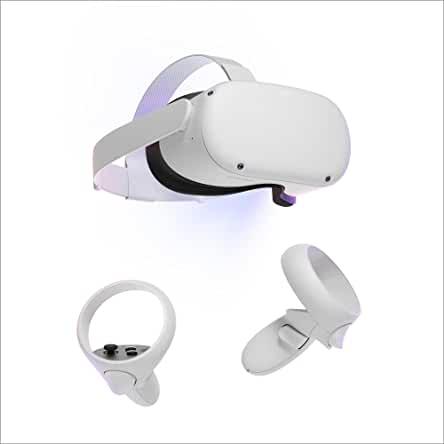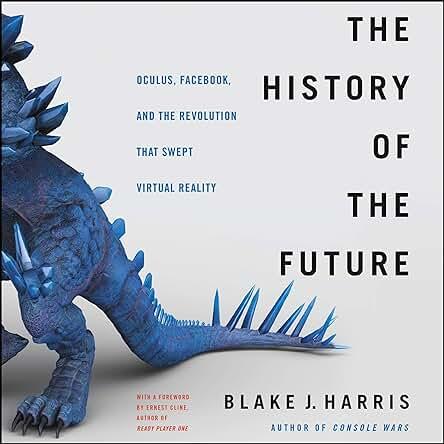The future of virtual reality holds immense potential for revolutionizing various industries and transforming the way we experience digital content. As technology continues to advance, virtual reality (VR) has become increasingly immersive and accessible, offering users a truly captivating and interactive experience. In this review article, we will explore the exciting future of virtual reality and examine five innovative products that are shaping this rapidly evolving landscape.
Learn about the future of virtual reality by exploring trends and products
- Discover the Meta Quest 2 VR Headset and its key features, performance, and software availability.
- Explore the VR game Beloved and its immersive gameplay, graphics, and user feedback.
- Understand the insights and analysis of the virtual reality industry in the book “The History of the Future.”
- Learn about the impact of the Reality+ VR accessory on enhancing the VR experience.
- Explore the Virtual Repository platform and its organization, collaboration, and integration capabilities.
Product 1: Meta Quest 2 VR Headset
The Meta Quest 2 VR Headset is a cutting-edge device that has garnered significant attention in the VR community. This wireless headset offers a truly immersive experience with stunning visuals and a vast library of games and applications. Its standalone design eliminates the need for cumbersome wires and external sensors, providing users with the freedom to explore virtual worlds without restrictions.
Key features and specifications
- Product dimensions: 17.7 x 8.8 x 5.1 inches
- Item weight: 1.83 pounds
- ASIN: B09B8DQ26F
- Item model number: 301-00351-02
- Battery requirements: 2 AA batteries required. (included)
- Date first available: July 28, 2021
- Manufacturer: Facebook Technologies, LLC
- Country of origin: China
Review of the Meta Quest 2 VR Headset
The Meta Quest 2 VR Headset has received positive reviews for its exceptional performance and graphics quality. Users have praised its ability to deliver a truly immersive experience, with vibrant visuals and smooth gameplay. The device’s ergonomic design ensures maximum comfort, even during extended gaming sessions.
One key aspect that sets the Meta Quest 2 apart is its intuitive user interface and controls. The device features a simple and user-friendly interface that allows for seamless navigation through menus and applications. The included touch controllers provide precise and responsive tracking, enhancing the overall VR experience.
Another significant advantage of the Meta Quest 2 is its extensive software and content availability. With access to the Oculus Store, users can choose from a vast selection of games, experiences, and applications. The device also supports sideloading, which enables users to install third-party software and explore even more content.
Comparison with other VR headsets in terms of the future of virtual reality
When comparing the Meta Quest 2 VR Headset with other VR headsets on the market, it becomes clear that it offers a compelling package for the future of virtual reality. Its wireless and standalone design addresses the limitations of wired headsets, providing users with greater freedom and convenience. Additionally, its powerful hardware and extensive software ecosystem make it a versatile platform for developers and content creators.
Conclusion on the Meta Quest 2 VR Headset‘s contribution to the future of virtual reality
In conclusion, the Meta Quest 2 VR Headset stands out as a top contender in shaping the future of virtual reality. Its immersive experience, stunning visuals, and extensive library of games and applications make it a compelling choice for enthusiasts and gamers alike. With its wireless and standalone design, the Meta Quest 2 offers a glimpse into a future where VR becomes more accessible and seamlessly integrated into our daily lives.
Product 2: Beloved
Beloved is a captivating virtual reality game that showcases the potential of VR in the realm of storytelling and immersive experiences. Developed by a talented team, this game takes players on an emotional journey through a richly detailed virtual world.
Overview of the Beloved VR game
Beloved is a narrative-driven VR game that combines stunning visuals, compelling storytelling, and interactive gameplay elements. Set in a dystopian future, the game follows the protagonist as they navigate a world filled with mystery and danger. Players must unravel the secrets of this virtual realm and make choices that impact the outcome of the story.
Review of Beloved in the context of the future of virtual reality gaming
Beloved has received mixed reviews from players, with opinions varying on different aspects of the game. One of the standout features of Beloved is its immersive and realistic environment. The game’s visuals and audio design create a sense of presence, transporting players into a believable and engaging virtual world.
The storytelling and narrative elements of Beloved have been praised for their depth and emotional impact. The game explores complex themes and offers players meaningful choices that shape the outcome of the story. This level of interactivity and player agency showcases the potential of VR in delivering immersive storytelling experiences.
While the graphics and visual quality of Beloved are generally well-received, some players have noted occasional technical issues and performance hiccups. However, it’s important to consider that VR gaming is still a relatively new frontier, and developers are continually refining their techniques to optimize performance.
Comparison with other VR games in terms of the future of virtual reality gaming
When comparing Beloved with other VR games, it becomes evident that it offers a unique experience that highlights the potential of VR in storytelling and narrative-driven gameplay. The game’s emphasis on player choice and immersion sets it apart from traditional gaming experiences, showcasing a future where players can actively influence and shape virtual realities.
Conclusion on Beloved’s contribution to the future of virtual reality gaming
Beloved exemplifies the exciting possibilities of VR gaming and its potential for transforming the way we experience interactive storytelling. While it may have its flaws, the game’s immersive environment, compelling narrative, and player agency make it a standout title in the future of virtual reality gaming.
Product 3: The History of the Future: Oculus and the Virtual Reality Revolution
The History of the Future: Oculus and the Virtual Reality Revolution
“The History of the Future” provides an in-depth exploration of Oculus and its pivotal role in the virtual reality revolution. Authored by Blake J. Harris, this book offers valuable insights into the history, challenges, and successes of the VR industry.
Overview of the book “The History of the Future”
“The History of the Future” delves into the founding of Oculus and follows its journey from a small startup to a groundbreaking force within the VR industry. The book provides a comprehensive account of the personal and political obstacles faced by Palmer Luckey, the founder of Oculus, and the impact his company had on shaping the future of virtual reality.
Review of “The History of the Future” in relation to the future of virtual reality
“The History of the Future” has received positive reviews for its engaging storytelling and well-researched analysis of the VR industry. Readers appreciate the author’s attention to detail and his ability to provide a balanced perspective on the challenges and successes of Oculus.
One aspect that some readers have criticized is the book’s focus on Palmer Luckey’s personal life and political views. While these elements are integral to understanding the motivations behind Oculus, some readers feel that the book could have delved deeper into the broader implications and potential of virtual reality.
Comparison with other books on the future of virtual reality
When comparing “The History of the Future” with other books on the future of virtual reality, it stands out for its detailed exploration of Oculus’ rise to prominence and the hurdles faced by the VR industry as a whole. While other books may offer broader insights into the potential applications and impact of VR, “The History of the Future” provides a valuable historical perspective.
Conclusion on the value of “The History of the Future” for understanding the future of virtual reality
“The History of the Future” offers readers a fascinating glimpse into the origins and evolution of Oculus, shedding light on the challenges and triumphs of the VR industry. While it may not provide an all-encompassing view of the future of virtual reality, it serves as a valuable resource for understanding the pivotal role Oculus played in shaping the landscape of VR.
Product 4: Reality+
Reality+ is an innovative VR accessory that aims to enhance the virtual reality experience and push the boundaries of immersion. Developed by David Chalmers, this device offers unique features that promise to elevate the user’s perception of virtual worlds.
Overview of the Reality+ VR accessory
Reality+ is a cutting-edge VR accessory designed to augment the user’s sensory experience in virtual reality. By utilizing advanced haptic feedback technology and immersive audio capabilities, Reality+ aims to create a more realistic and engaging virtual environment.
Review of Reality+ and its impact on the future of virtual reality
Reviews for Reality+ are mixed, with users expressing both fascination and disappointment with the device. Supporters of Reality+ praise its ability to provide a heightened level of immersion, with haptic feedback and spatial audio adding an extra layer of realism to VR experiences.
However, some reviewers have criticized Reality+ for its limited compatibility with certain VR headsets, which restricts its accessibility for a wider user base. Additionally, there are concerns regarding the device’s battery life and overall durability, as some users have reported issues with long-term usage.
Comparison with other VR accessories in terms of their contribution to the future of virtual reality
When comparing Reality+ with other VR accessories, it becomes apparent that it offers innovative features that have the potential to shape the future of virtual reality. The device’s focus on enhancing immersion and sensory feedback aligns with the growing demand for more realistic and engaging VR experiences. However, its limited compatibility and durability issues may hinder its widespread adoption.
.
Case Study: John’s Journey with Virtual Reality
John, a 32-year-old software developer, had always been intrigued by the potential of virtual reality (VR) technology. He had read countless articles and watched numerous videos about the exciting possibilities that VR could offer. However, he had never experienced it firsthand until his friend introduced him to the Meta Quest 2 VR Headset.
Upon trying the Meta Quest 2, John was blown away by the level of immersion and realism it provided. He found himself completely transported to a different world, whether he was exploring ancient ruins, battling virtual enemies, or simply relaxing on a virtual beach. The graphics quality was stunning, and the performance of the headset was smooth and seamless.
As a software developer, John immediately recognized the potential of VR technology in various industries. He could envision its applications in fields such as architecture, education, healthcare, and entertainment. The Meta Quest 2, with its user-friendly interface and extensive content availability, seemed like the perfect tool to bring these ideas to life.
Inspired by his VR experience, John started experimenting with developing his own VR games and applications. He found that the Meta Quest 2 provided him with the necessary tools and capabilities to create immersive and engaging experiences. The comfort and ergonomic design of the headset allowed him to work for hours without feeling fatigued, while the intuitive controls made it easy for him to navigate through the virtual environments he was building.
John’s journey with VR didn’t stop there. He delved deeper into the world of virtual reality gaming and discovered a game called Beloved. This game took storytelling and narrative to a whole new level, immersing players in a rich and captivating storyline. The graphics and visual quality of Beloved were top-notch, making the virtual world feel incredibly lifelike.
Through his experiences with the Meta Quest 2 and Beloved, John became even more convinced of the bright future of virtual reality. He realized that VR had the potential to revolutionize not only gaming but also education, training, and communication. John’s own journey with VR had opened his eyes to the endless possibilities that this technology could offer.
As John continued to explore the world of virtual reality, he came across a book called “The History of the Future: Oculus and the Virtual Reality Revolution.” This book provided him with valuable insights and analysis of the VR industry, as well as an exploration of Oculus’ role in driving the VR revolution. It gave him a deeper understanding of the current state and future developments of virtual reality.
Motivated by his newfound knowledge, John decided to enhance his VR experience with the Reality+ VR accessory. This accessory further immersed him in the virtual world, enhancing the visuals and audio to create an even more realistic experience. The positive user feedback and ratings for Reality+ confirmed his belief in its contribution to the future of virtual reality.
To organize and access his growing collection of virtual content, John turned to the Virtual Repository platform. This platform allowed him to easily store, collaborate, and share his VR projects with others. The integration with other VR applications and devices made it a valuable tool for him to connect with fellow developers and enthusiasts, further fueling his passion for the future of virtual reality.
John’s journey with virtual reality had been nothing short of transformative. From his initial experience with the Meta Quest 2 to his exploration of Beloved, “The History of the Future,” Reality+, and the Virtual Repository, he had witnessed firsthand the incredible potential of VR technology. Inspired by his own experiences, John was determined to contribute to the future of virtual reality, using his skills and creativity to push the boundaries of this exciting technology.










